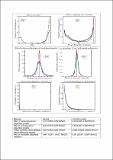Files in this item
Effect of eccentricity on disparity distributions in binocular natural images
Item metadata
| dc.contributor.author | Hunter, David William | |
| dc.contributor.author | Hibbard, Paul Barry | |
| dc.date.accessioned | 2014-09-09T15:01:01Z | |
| dc.date.available | 2014-09-09T15:01:01Z | |
| dc.date.issued | 2014 | |
| dc.identifier | 145085316 | |
| dc.identifier | ff77e7cf-42ad-4685-b6e1-1ac86f500a5e | |
| dc.identifier.citation | Hunter , D W & Hibbard , P B 2014 , ' Effect of eccentricity on disparity distributions in binocular natural images ' , Journal of Vision , vol. 14 , no. 10 , 973 . https://doi.org/10.1167/14.10.973 | en |
| dc.identifier.issn | 1534-7362 | |
| dc.identifier.uri | https://hdl.handle.net/10023/5399 | |
| dc.description.abstract | Sparse statistical representations of natural images produce energy efficient components resembling the responses of simple cells in V1. These models assume that the statistics are spatially stationary, when in fact these statistics are known to vary across the image. We analysed the effect of eccentricity on the independent components of binocular images. A set of binocular image pairs were divided into three regions according to distance from the focal point. For each region separate FastICA models were trained using 100,000 patches 2x25x25 pixels in size. 4000 components per region were generated in batches of 200. Pairs of Gabor functions were fitted to each component. The binocularity of components decreased with increasing eccentricity. The differences in position, phase and orientation within each pair were used as measures of disparity tuning. This was only done for clearly binocular components. Confidence intervals were calculated using 200 bootstraps. The spread of the distribution of preferred horizontal position disparity was greater for samples from more eccentric image locations. In contrast, the spread of preferred vertical position disparity was not affected by eccentricity. The distribution of phase disparities was markedly less symmetric towards the centre of the image compared with eccentric regions. More components were tuned to large phase disparities in the centre of the image than elsewhere. Orientation disparities showed a small but significant decrease with eccentricity. From the geometry of binocular vision the observed distributions of horizontal and vertical disparities is to be expected. The asymmetrical distribution of preferred phase disparities was not predicted, since the role of phase in disparity detection is not yet fully understood. | |
| dc.format.extent | 1 | |
| dc.format.extent | 333118 | |
| dc.format.extent | 143280 | |
| dc.language.iso | eng | |
| dc.relation.ispartof | Journal of Vision | en |
| dc.subject | Binocular vision | en |
| dc.subject | Disparity | en |
| dc.subject | BF Psychology | en |
| dc.subject | Neuropsychology and Physiological Psychology | en |
| dc.subject.lcc | BF | en |
| dc.title | Effect of eccentricity on disparity distributions in binocular natural images | en |
| dc.type | Journal item | en |
| dc.contributor.sponsor | BBSRC | en |
| dc.contributor.institution | University of St Andrews. School of Psychology and Neuroscience | en |
| dc.contributor.institution | University of St Andrews. Institute of Behavioural and Neural Sciences | en |
| dc.identifier.doi | https://doi.org/10.1167/14.10.973 | |
| dc.description.status | Peer reviewed | en |
| dc.identifier.url | http://www.journalofvision.org/content/14/10/973.short?rss=1&cited-by=yes&legid=jov;14/10/973 | en |
| dc.identifier.grantnumber | DGB1500 | en |
This item appears in the following Collection(s)
Items in the St Andrews Research Repository are protected by copyright, with all rights reserved, unless otherwise indicated.


